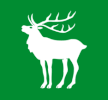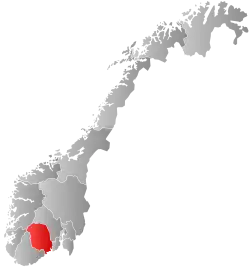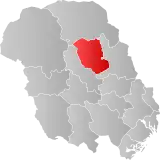Hjartdal Municipality
Hjartdal kommune | |
|---|---|
 View of the Hjartdal wilderness | |
 Flag | |
 Telemark within Norway | |
 Hjartdal within Telemark | |
| Coordinates: 59°39′54″N 8°43′34″E / 59.66500°N 8.72611°E | |
| Country | Norway |
| County | Telemark |
| District | Aust-Telemark |
| Established | 1 Jan 1838 |
| • Created as | Formannskapsdistrikt |
| Administrative centre | Sauland |
| Government | |
| • Mayor (2015) | Bengt Halvard Odden (Ap) |
| Area | |
| • Total | 791.60 km2 (305.64 sq mi) |
| • Land | 737.12 km2 (284.60 sq mi) |
| • Water | 54.48 km2 (21.03 sq mi) 6.9% |
| • Rank | #146 in Norway |
| Population (2022) | |
| • Total | 1,562 |
| • Rank | #299 in Norway |
| • Density | 2.1/km2 (5/sq mi) |
| • Change (10 years) | |
| Demonym | Hjartdøl[1] |
| Official language | |
| • Norwegian form | Nynorsk |
| Time zone | UTC+01:00 (CET) |
| • Summer (DST) | UTC+02:00 (CEST) |
| ISO 3166 code | NO-4024[3] |
| Website | Official website |
Hjartdal is a municipality in Telemark county, Norway. It is located in the traditional district of Upper Telemark and Aust-Telemark. The administrative centre of the municipality is the village of Sauland. Other villages in the municipality include Tuddal and Hjartdalsbygda.
The 792-square-kilometre (306 sq mi) municipality is the 146th largest by area out of the 356 municipalities in Norway. Hjartdal is the 299th most populous municipality in Norway with a population of 1,562. The municipality's population density is 2.1 inhabitants per square kilometre (5.4/sq mi) and its population has decreased by 2.5% over the previous 10-year period.[4][5]
General information
The municipality of Hierdal was established as a municipality on 1 January 1838 (see formannskapsdistrikt). In 1860, the Gransherad area of eastern Hjartdal (population: 1,310) was separated to become part of the new Gransherad Municipality. Also in 1860, the administrative centre of the municipality was moved from Hjartdalsbygda to Sauland. On 23 January 1905, a small, unpopulated area of Hjartdal was transferred to the neighboring Seljord Municipality.[6]
Name
The municipality (originally the parish) is named after the valley name, Hjartdalen (Old Norse: Hjartdalr) since the first Hjartdal Church was built there. The first element is the old name for the local river Hjartdøla. The old river name is likely derived from the word hjǫrtr which means "red deer". The last element is dalr which means "valley" or "dale". Prior to the 20th century, the name was often spelled Hierdal, a corruption of the original name. In the 20th century, the spelling was standardized to Hjartdal, bringing back more of the original spelling.[7]
Coat of arms
The coat of arms was granted on 17 February 1989. The official blazon is "Vert, a deer at bay argent" (Norwegian: På grøn grunn ein ståande sølv hjort). This means the arms have a green field (background) and the charge is a red deer (Cervus elaphus) standing at bay. The deer has a tincture of argent which means it is commonly colored white, but if it is made out of metal, then silver is used. They are canting arms because the name of the municipality is derived from the word for deer, a common animal in the rural municipality. The color green was chosen to represent the forests in the area. The arms were designed by Svein G. Carlsen. The municipal flag has the same design as the coat of arms.[8][9][10][11]
Churches
The Church of Norway has one parish (sokn) within the municipality of Hjartdal. It is part of the Øvre Telemark prosti (deanery) in the Diocese of Agder og Telemark.
| Parish (sokn) | Church name | Location of the church | Year built |
|---|---|---|---|
| Hjartdal | Hjartdal Church | Hjartdalsbygda | 1809 |
| Sauland Church | Sauland | 1863 | |
| Tuddal Church | Tuddal | 1796 |
History
Up to the 1500s, the Hjartdal parish had been quite large. It stretched from Rauland in the west and Kongsberg to the east. Counting from west to east, the villages of Åmotsdal, Svartdal, Hjartdal, Tuddal, Sauland, Gransherad, Bolkesjø, Jondalen and Lisleherad were all at one point included in the same parish. Sometime after 1687[12] Lisleherad was transferred to the partish of Heddal. Then in 1860, the Gransherad area was separated. Today, the Hjartdal parish and municipality consists of the three main village areas: Hjartdalsbygda, Sauland, and Tuddal.[13][14]
Government
All municipalities in Norway are responsible for primary education (through 10th grade), outpatient health services, senior citizen services, welfare and other social services, zoning, economic development, and municipal roads and utilities. The municipality is governed by a municipal council of directly elected representatives. The mayor is indirectly elected by a vote of the municipal council.[15] The municipality is under the jurisdiction of the Telemark District Court and the Agder Court of Appeal.
Mayors
The mayors (Norwegian: ordførar) of Hjartdal (incomplete list):
- 1837/38-1841: Gunleik Olsen Bolkesjø
- 1841-ab.1844: Gunleik Torbjørnsen Omnes
- ab.1843-1847: Mathias Mathiassen Kleppen
- incomplete
- 1859-1872: Torkel Olsen Mosebø
- incomplete
- 1877-1879: Leif Gregarsen Særsland
- incomplete
- ab.1890-NA: Kjetil Olsen Dahlen
- 1895-ab.1908: Ole Torkildsen Mosebø
- 1898-NA: Nils Flugon
- incomplete
- ab.1920-NA: Torgrim Mathiassen Kleppen
- ab.1921-1923: Ole Gunleiksen Hafsteen
- incomplete
- 1928-1940/41: Knut Halvorsen Hovde
- 1941-1944: Mathis Torbjørnsen
- 1946-ab.1947: Johannes H. Strand
- 1947-ab.1961: Olav Olsen Asland
- 1962/63-1975: Søren Johnsen Bekkhus
- 1975-1979 Olav Johnsen Bøen
- 1979/80-1986: Thomas Harald Timland (Sp)
- 1985/86-1989: Knut Olsen Bekkhus
- 1989-1991: Olav Tho (Sp)
- 1991-1999: Torunn Hovde Kaasa (Sp)
- 1999-2011: Olav Tho (Sp)
- 2011-2015: Sven Tore Løkslid (Ap)
- 2015–present: Bengt Halvard Odden (Ap)
Municipal council
The municipal council (Kommunestyre) of Hjartdal is made up of 17 representatives that are elected to four year terms. The tables below show the current and historical composition of the council by political party.
| Party name (in Nynorsk) | Number of representatives | |
|---|---|---|
| Labour Party (Arbeidarpartiet) | 8 | |
| Christian Democratic Party (Kristeleg Folkeparti) | 2 | |
| Centre Party (Senterpartiet) | 7 | |
| Total number of members: | 17 | |
| Party name (in Nynorsk) | Number of representatives | |
|---|---|---|
| Labour Party (Arbeidarpartiet) | 7 | |
| Conservative Party (Høgre) | 2 | |
| Christian Democratic Party (Kristeleg Folkeparti) | 2 | |
| Centre Party (Senterpartiet) | 6 | |
| Total number of members: | 17 | |
| Party name (in Nynorsk) | Number of representatives | |
|---|---|---|
| Labour Party (Arbeidarpartiet) | 11 | |
| Christian Democratic Party (Kristeleg Folkeparti) | 2 | |
| Centre Party (Senterpartiet) | 4 | |
| Total number of members: | 17 | |
| Party name (in Nynorsk) | Number of representatives | |
|---|---|---|
| Labour Party (Arbeidarpartiet) | 7 | |
| Christian Democratic Party (Kristeleg Folkeparti) | 4 | |
| Centre Party (Senterpartiet) | 6 | |
| Total number of members: | 17 | |
| Party name (in Nynorsk) | Number of representatives | |
|---|---|---|
| Labour Party (Arbeidarpartiet) | 6 | |
| Christian Democratic Party (Kristeleg Folkeparti) | 5 | |
| Centre Party (Senterpartiet) | 6 | |
| Total number of members: | 17 | |
| Party name (in Nynorsk) | Number of representatives | |
|---|---|---|
| Labour Party (Arbeidarpartiet) | 5 | |
| Christian Democratic Party (Kristeleg Folkeparti) | 5 | |
| Centre Party (Senterpartiet) | 7 | |
| Total number of members: | 17 | |
| Party name (in Nynorsk) | Number of representatives | |
|---|---|---|
| Labour Party (Arbeidarpartiet) | 7 | |
| Conservative Party (Høgre) | 1 | |
| Christian Democratic Party (Kristeleg Folkeparti) | 2 | |
| Centre Party (Senterpartiet) | 11 | |
| Total number of members: | 21 | |
| Party name (in Nynorsk) | Number of representatives | |
|---|---|---|
| Labour Party (Arbeidarpartiet) | 8 | |
| Conservative Party (Høgre) | 2 | |
| Christian Democratic Party (Kristeleg Folkeparti) | 3 | |
| Centre Party (Senterpartiet) | 8 | |
| Total number of members: | 21 | |
| Party name (in Nynorsk) | Number of representatives | |
|---|---|---|
| Labour Party (Arbeidarpartiet) | 12 | |
| Conservative Party (Høgre) | 3 | |
| Christian Democratic Party (Kristeleg Folkeparti) | 5 | |
| Centre Party (Senterpartiet) | 5 | |
| Total number of members: | 25 | |
| Party name (in Nynorsk) | Number of representatives | |
|---|---|---|
| Labour Party (Arbeidarpartiet) | 11 | |
| Conservative Party (Høgre) | 3 | |
| Christian Democratic Party (Kristeleg Folkeparti) | 5 | |
| Centre Party (Senterpartiet) | 6 | |
| Total number of members: | 25 | |
| Party name (in Nynorsk) | Number of representatives | |
|---|---|---|
| Labour Party (Arbeidarpartiet) | 10 | |
| Conservative Party (Høgre) | 3 | |
| Christian Democratic Party (Kristeleg Folkeparti) | 5 | |
| Centre Party (Senterpartiet) | 7 | |
| Total number of members: | 25 | |
| Party name (in Nynorsk) | Number of representatives | |
|---|---|---|
| Labour Party (Arbeidarpartiet) | 10 | |
| Christian Democratic Party (Kristeleg Folkeparti) | 5 | |
| Joint list of the Centre Party (Senterpartiet) and the Liberal Party (Venstre) | 10 | |
| Total number of members: | 25 | |
| Party name (in Nynorsk) | Number of representatives | |
|---|---|---|
| Labour Party (Arbeidarpartiet) | 10 | |
| Joint List(s) of Non-Socialist Parties (Borgarlege Felleslister) | 15 | |
| Total number of members: | 25 | |
| Party name (in Nynorsk) | Number of representatives | |
|---|---|---|
| Labour Party (Arbeidarpartiet) | 11 | |
| Joint List(s) of Non-Socialist Parties (Borgarlege Felleslister) | 14 | |
| Total number of members: | 25 | |
| Party name (in Nynorsk) | Number of representatives | |
|---|---|---|
| Labour Party (Arbeidarpartiet) | 11 | |
| Joint List(s) of Non-Socialist Parties (Borgarlege Felleslister) | 14 | |
| Total number of members: | 25 | |
| Party name (in Nynorsk) | Number of representatives | |
|---|---|---|
| Labour Party (Arbeidarpartiet) | 11 | |
| Joint List(s) of Non-Socialist Parties (Borgarlege Felleslister) | 14 | |
| Total number of members: | 25 | |
| Party name (in Nynorsk) | Number of representatives | |
|---|---|---|
| Labour Party (Arbeidarpartiet) | 11 | |
| Joint List(s) of Non-Socialist Parties (Borgarlege Felleslister) | 14 | |
| Total number of members: | 25 | |
| Party name (in Nynorsk) | Number of representatives | |
|---|---|---|
| Labour Party (Arbeidarpartiet) | 10 | |
| Joint List(s) of Non-Socialist Parties (Borgarlege Felleslister) | 14 | |
| Total number of members: | 24 | |
| Party name (in Nynorsk) | Number of representatives | |
|---|---|---|
| Labour Party (Arbeidarpartiet) | 2 | |
| Christian Democratic Party (Kristeleg Folkeparti) | 2 | |
| Farmers' Party (Bondepartiet) | 4 | |
| Total number of members: | 8 | |
| Party name (in Nynorsk) | Number of representatives | |
|---|---|---|
| Labour Party (Arbeidarpartiet) | 16 | |
| Joint List(s) of Non-Socialist Parties (Borgarlege Felleslister) | 18 | |
| Local List(s) (Lokale lister) | 2 | |
| Total number of members: | 36 | |
| Party name (in Nynorsk) | Number of representatives | |
|---|---|---|
| Labour Party (Arbeidarpartiet) | 15 | |
| Farmers' Party (Bondepartiet) | 4 | |
| Joint List(s) of Non-Socialist Parties (Borgarlege Felleslister) | 13 | |
| Local List(s) (Lokale lister) | 4 | |
| Total number of members: | 36 | |
| Note: Due to the German occupation of Norway during World War II, no elections were held for new municipal councils until after the war ended in 1945. | ||
Geography
The rural municipality is located in the mountains of Telemark. The mountain Gaustatoppen is located on the northern border of the municipality. The main river of the municipality is the Hjartdøla which empties into the Heddøla river at Sauland.
Transportation
The European route E134 highway runs through the municipality. The Mælefjell Tunnel is a road tunnel that is part of the E134 highway and it runs through the Mælefjell mountain.
Notable people
- Hans Paus (1656–1715), a Norwegian priest and poet
- Drengman Aaker (1839–1894), an American politician and businessman who served in the Iowa House of Representatives
- Kittel Halvorson (1846–1936), a farmer and U.S. Representative from Minnesota
- Knut Buen (born 1948), a Norwegian fiddler, composer, folklorist, and publisher who lives in Tuddal
- Sven Tore Løkslid, (Norwegian Wiki) (born 1984), the county governor of Telemark and former mayor of Hjartdal
References
- ↑ "Navn på steder og personer: Innbyggjarnamn" (in Norwegian). Språkrådet.
- ↑ "Forskrift om målvedtak i kommunar og fylkeskommunar" (in Norwegian). Lovdata.no.
- ↑ Bolstad, Erik; Thorsnæs, Geir, eds. (26 January 2023). "Kommunenummer". Store norske leksikon (in Norwegian). Kunnskapsforlaget.
- ↑ Statistisk sentralbyrå. "Table: 06913: Population 1 January and population changes during the calendar year (M)" (in Norwegian).
- ↑ Statistisk sentralbyrå. "09280: Area of land and fresh water (km²) (M)" (in Norwegian).
- ↑ Jukvam, Dag (1999). "Historisk oversikt over endringer i kommune- og fylkesinndelingen" (PDF) (in Norwegian). Statistisk sentralbyrå. ISBN 9788253746845.
- ↑ Rygh, Oluf (1914). Norske gaardnavne: Bratsbergs amt (in Norwegian) (7 ed.). Kristiania, Norge: W. C. Fabritius & sønners bogtrikkeri. pp. 297–298.
- ↑ "Civic heraldry of Norway - Norske Kommunevåpen". Heraldry of the World. Retrieved 16 August 2023.
- ↑ "Hjartdal, Telemark (Norway)". Flags of the World. Retrieved 16 August 2023.
- ↑ "Godkjenning av våpen og flagg". Lovdata.no (in Norwegian). Norges kommunal- og arbeidsdepartementet. 14 April 1989. Retrieved 16 August 2023.
- ↑ "Hjartdal kommune, våpen". Digitalarkivet (in Norwegian). Arkivverket. Retrieved 16 August 2023.
- ↑ "Rentekammeret inntil 1814, Reviderte regnskaper, Fogderegnskap, R35/L2086: Fogderegnskap Øvre og Nedre Telemark, 1687-1689" (in Norwegian). Riksarkivvet. p. 69.
- ↑ "Cultural Centre in Telemark".
- ↑ "Hitterdalsboken : gaarde og slegter" (in Norwegian).
- ↑ Hansen, Tore; Vabo, Signy Irene, eds. (20 September 2022). "kommunestyre". Store norske leksikon (in Norwegian). Kunnskapsforlaget. Retrieved 14 October 2022.
- ↑ "Tall for Norge: Kommunestyrevalg 2019 - Vestfold og Telemark". Valg Direktoratet. Retrieved 16 August 2023.
- ↑ "Tall for Norge: Kommunestyrevalg 2015 - Telemark". Valg Direktoratet.
- 1 2 3 4 "Table: 04813: Members of the local councils, by party/electoral list at the Municipal Council election (M)" (in Norwegian). Statistics Norway.
- ↑ "Tall for Norge: Kommunestyrevalg 2011 - Telemark". Valg Direktoratet.
- ↑ "Kommunestyrevalget 1999" (PDF) (in Norwegian). Oslo-Kongsvinger, Norge: Statistisk sentralbyrå. 2000. ISBN 8253748531. ISSN 0332-8023.
- ↑ "Kommunestyrevalget 1995" (PDF) (in Norwegian). Oslo-Kongsvinger, Norge: Statistisk sentralbyrå. 1996. ISBN 8253743351. ISSN 0332-8023.
- ↑ "Kommunestyrevalget 1991" (PDF) (in Norwegian). Oslo-Kongsvinger, Norge: Statistisk sentralbyrå. 1993. ISBN 8253737939. ISSN 0332-8023.
- ↑ "Kommunestyrevalget 1987" (PDF) (in Norwegian). Oslo-Kongsvinger, Norge: Statistisk sentralbyrå. 1988. ISBN 8253726325. ISSN 0332-8023.
- ↑ "Kommunestyrevalget 1983" (PDF) (in Norwegian). Oslo-Kongsvinger, Norge: Statistisk sentralbyrå. 1984. ISBN 8253720378. ISSN 0332-8023.
- ↑ "Kommunestyrevalget 1979" (PDF) (in Norwegian). Oslo, Norge: Statistisk sentralbyrå. 1979. ISBN 8253710836. ISSN 0332-8023.
- ↑ "Kommunevalgene 1975" (PDF) (in Norwegian). Oslo, Norge: Statistisk sentralbyrå. 1977. ISBN 8253705646.
- ↑ "Kommunevalgene 1972" (PDF) (in Norwegian). Oslo, Norge: Statistisk sentralbyrå. 1973. ISBN 8253701144.
- ↑ "Kommunevalgene 1967" (PDF) (in Norwegian). Oslo, Norge: Statistisk sentralbyrå. 1967.
- ↑ "Kommunevalgene 1963" (PDF) (in Norwegian). Oslo, Norge: Statistisk sentralbyrå. 1964.
- ↑ "Kommunevalgene og Ordførervalgene 1959" (PDF) (in Norwegian). Oslo, Norge: Statistisk sentralbyrå. 1960.
- ↑ "Kommunevalgene og Ordførervalgene 1955" (PDF) (in Norwegian). Oslo, Norge: Statistisk sentralbyrå. 1957.
- ↑ "Kommunevalgene og Ordførervalgene 1951" (PDF) (in Norwegian). Oslo: Statistisk sentralbyrå. 1952.
- ↑ "Kommunevalgene og Ordførervalgene 1947" (PDF) (in Norwegian). Oslo: Statistisk sentralbyrå. 1948.
- ↑ "Kommunevalgene og Ordførervalgene 1945" (PDF) (in Norwegian). Oslo: Statistisk sentralbyrå. 1947.
- ↑ "Kommunevalgene og Ordførervalgene 1937" (PDF) (in Norwegian). Oslo: Statistisk sentralbyrå. 1938.
External links
 The dictionary definition of Hjartdal at Wiktionary
The dictionary definition of Hjartdal at Wiktionary- Municipal fact sheet from Statistics Norway (in Norwegian)
 Telemark travel guide from Wikivoyage
Telemark travel guide from Wikivoyage

